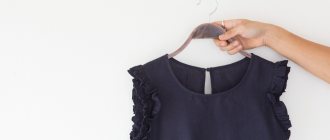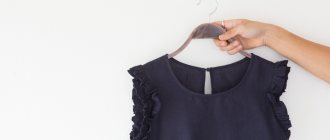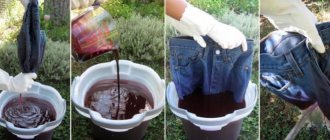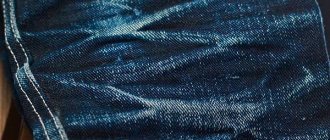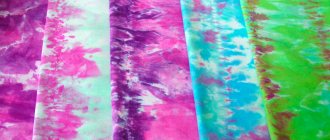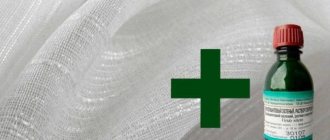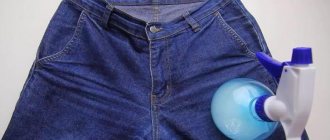Jeans have long become items of the basic wardrobe of all fashionistas and fashionistas; it is difficult to imagine an everyday look without them. Pairing them with sophisticated shoes, a classic jacket and jewelry, you can create an image for a date, an exhibition or any celebration. But in this material we want to talk about how to dye jeans black. Some time ago, fashionistas and women of fashion knew all the subtleties of dyeing such fabric; today, traditional methods have been joined by more modern ones, accompanied by minimal labor costs. These are the ones we will talk about.
What you need to know
Every modern housewife can dye jeans black at home; this does not require any special skills. But before you start work, it is necessary to carry out a number of preparatory measures:
- Analysis - the decision to dye denim should be balanced: analyze all the pros and cons of the procedure, prepare for a negative outcome. It should be understood that coloring at home is a risk, a roulette, the result can be both positive and negative.
- Fabric composition - natural fabrics, such as cotton, are the most susceptible to dyeing. If your jeans are made primarily of synthetic fabrics, the dyeing result may not meet your expectations; you will have to repeat the procedure many times to obtain a rich, bright shade.
- The original color is something that should definitely be taken into account. If you decide to dye your white jeans black, you will end up with jeans with a grayish tint. That is why, to obtain an expressive color, it is better to choose tones that are close in combination.
- Protective equipment - when working with dyes, arm yourself with rubber gloves, which can be purchased at any hardware store.
- Compliance with recommendations - the manufacturer leaves recommendations and useful tips on the packaging with the dye, so to get maximum results you should follow them unquestioningly.
Ways to use dyes
There are options to refresh faded colors and completely change the look of a piece. What paint to paint your trousers depends on the availability of funds and the complexity of the process.
Blue
Using the available dye methylene blue mixed with starch, you can update the item or repaint it blue (white item). For this you will need:
- Pour warm water not exceeding 30° C into a medium-sized container and add blue, independently controlling the color saturation. For long-lasting results, add 3 tbsp to the solution. l. salt.
- Jeans soaked in a blue solution are left to expose the paint for several hours, periodically turning the product over.
- After the time has passed, prepare a reservoir of cold water in which 1 tbsp is diluted. l. vinegar per 1 liter of water, where the jeans are thoroughly rinsed.
Blue is not the best option for long-term dyeing; it is used to restore the color of the product, not change it.
Potassium permangantsovka
“Boiled jeans”, which came from the 80s, can be created using potassium permanganate. The difference from the traditional method is the complete absence of heat treatment.
- First, prepare a solution: 135 ml of vinegar 9% with 80 g of potassium permanganate, with the addition of 30 ml of hydrogen peroxide 3%.
- Keeping a 2:1 ratio, fill a reservoir with water and pour in the prepared mixture.
- The pants are twisted into a rope and secured with ropes or elastic bands.
- The prepared product, which must be completely immersed under water, is placed in the solution for 20 minutes.
- After the required period has passed, the jeans are rinsed by hand, followed by machine washing.
Aniline dyes
In addition to dyeing denim fabric in classic blue, they can be given a different color using aniline dyes, the choice of which is huge. They come in both imported and domestic production. For greater convenience, two types of dyes are available:
- Powder.
- Liquid.
The advantage of the first option is that you can dye your jeans in the washing machine. It is most convenient to follow the instructions that come with each type of dye. However, there are universal methods that differ from each other in a few nuances:
- Before dyeing denim not only bright, but also black, the trousers must be washed to remove dirt and dust. There is no need to add rinse aids, they will change the final result.
- The pants are turned inside out.
- It is important to dissolve the powder dye so that lumps and small particles disappear completely; they leave unwanted stains.
The solution should be stirred in half a liter of water. If the package indicates that you need to add baking soda or salt, do not neglect these recommendations. All the proposed ingredients allow you to consolidate the coloring result. - A colored solution is added to the jeans placed in the washing machine. By setting the temperature to 95 °C, a long wash cycle is selected.
- Before the washing process is completed, prepare a container with cool water, where 9% vinegar is added (1 tablespoon per 1 liter of water). After the drum stops working, you need to immerse the jeans in the prepared water for 30 minutes.
- The end of the process is to re-wash the product, but with the addition of washing powder. The mode should be short and the temperature should not exceed 40 °C.
On a note
Drying in the drum of a washing machine should be avoided; it is better if the pants dry naturally, without being exposed to sunlight.
In order to change the color of black pants, you should first bleach them, and then proceed to the necessary dyeing.
Liquid aniline allows you to achieve incredible results. It can be used for plain coloring and to create an unusual pattern. To completely repaint the product, you can use the boiling method, but it is recommended to avoid this method. It negatively affects the structure of the jeans fabric, which leads to subsequent destruction of the fibers. It is worth choosing the option of using a washing machine, which will preserve the product and allow you to achieve better results.
Aniline paints are best used to create drawings:
- Due to the ability of jeans paint to spread, you can achieve unusual effects when one color flows into another, then into a third, fourth, and so on.
- By adding paint to a spray bottle, a splash pattern is created.
- To prevent the paint from spreading and to get a more formal design, you can use tragacanth glue, purchased at a specialized store, or made yourself. To do this, you will need petals of a rubber bush, dissolved in cold water (15 leaves of tragacanth for one glass). The solution is infused for a day, after which the liquid is passed through thin gauze, and the undissolved particles are again filled with water. In a ratio of 1:3, prepared glue is added to the aniline dye for denim.
Another way to make the paint thicker is with a primer. 3 g of gelatin crystals are dissolved in 1 liter of hot water, where the denim product is soaked, after which it is dried and ironed.
Acrylic paint
When choosing what to dye your jeans with, you should opt for acrylic dyes, which penetrate deeply into the fibers of the fabric and are firmly fixed there.
Even black jeans can be dyed this way, but the color will not be uniform; acrylic is used for design decisions when it is necessary to create a pattern on the fabric. To ensure longevity of the result and to avoid cracking of the paint, you should avoid layering large amounts of acrylic. It is better if you first apply an outline to the product with a pencil, and then proceed to further coloring. In order for the result to exceed expectations, you need to take into account the following recommendations:
- work quickly with the brush to avoid unnecessary dried contours;
- do paint tests on a piece of rough fabric;
- go from light to dark shades;
- the contour is drawn with a thin brush with soft bristles;
- For painting, choose brushes with synthetic bristles.
When the drawing is ready, you should wait 10-15 hours and iron the pants, turning the jeans inside out.
Plastisol paints
Fluorescent inks are more often used in screen printing. However, dye manufacturers have released variations of phosphor-based toners specifically for handmade lovers, which allows you to work with pigments at home.
Creating a glowing image is not difficult, you just need to know the sequence of actions:
- clean pants from dirt, wash them;
- Apply the first layer of the design with a synthetic brush;
- subsequent layers are applied after the previous ones have completely dried.
When finished, you should leave the jeans at rest for 2-3 hours. The paint looks brighter if the base is light colors. The glow is charged from daylight by accumulation, 20-30 minutes is enough.
Natural dyes
Connoisseurs of true handicraft love to use denim dye made from natural products without the use of chemical components. This method takes a lot of time, but the process is enjoyable. The main rule in creating the desired result is experimentation. The final color depends on the amount of ingredients used and the duration of exposure of the product to the dye.
Of course, dark colors cannot be dyed, but light jeans turn out to be surprisingly interesting. The main products that allow you to color the material:
- Beets, blueberries - from pink to red shades.
- Blackberries or red cabbage - blue and purple colors.
- Onion skins are copper and mustard in color.
- Citrus peels will give the material a yellow color.
- Spinach is green.
Before starting work, you should test the resulting dye on a small section using rubber gloves and an apron:
- It is necessary to soak jeans in a diluted solution of natural dye using a large container, preferably made of stainless steel.
- For best results, you should find soft demineralized water.
- Add a spoonful of baking soda to the diluted liquid.
- Before painting, the ingredients must be cut and boiled in water for about an hour. The color saturation is affected by the amount of infusion time, therefore, it is better to leave the pan overnight, then strain through thin cheesecloth and use it as a coloring.
- The number of dyeing stages is affected by the density of the material, so it is necessary to soak the product in the dye the number of times necessary for the final result.
When finished, rinse the jeans under running water until the stream becomes clear.
Waxing
After dyeing, a denim product can be given an unusual look using the waxing technique.
This version of wax impregnation looks stylish and protects the product from external influences. Coloring after waxing is more resistant to drying. For the procedure, you purchase a special wax, or create it yourself using linseed oil, turpentine and beeswax:
- As with all manipulations of jeans dyeing, the product is washed to remove dirt;
- It is better to melt the wax in a water bath to interact with the fabric;
- carefully spread the wax over the surface of the product with a soft sponge;
- the layer should be thin;
- During the process, the product is periodically dried with a household hairdryer;
- leave the jeans in a dry place for several hours.
There are many dyeing methods and types of dye, the main thing is to choose the right one for yourself. You need to experiment to understand where the result is better. The jeans don't just need blue dye, I change the color of the pants to different shades depending on the original look. Do not forget that the product requires special care after manipulation. It is recommended to wash in cool water and only by hand without using a washing machine.
© 2021 textiletrend.ru
Wash
How to dye jeans black so that the shade is even and rich? To do this, first of all, it is necessary to remove all dirt from the product - wash it using modern means. And here’s what’s important: under no circumstances use rinse aids and conditioners for washing, which, due to their density, can complicate the further dyeing process.
Is it worth using an automatic car?
Yes. This will not affect the quality of further operation of the machine. For your own peace of mind, after finishing painting, wipe the drum and rubber seal SMA with a light cloth or paper towel.
Expert opinion
Irina. Housewife.
Ask a Question
If suddenly there are traces of pigment on them - this happens very rarely - activate the rinse mode. It is important to consider the weight of the product: when dry, one pair weighs 600-900 grams.
Process steps:
- The dye solution is poured into the drum (powder and laundry conditioner are not added).
- The prepared jeans (clean and rinsed) turned inside out are placed in the machine.
- If indicated in the instructions, pour a portion of ordinary kitchen salt into the drum, which acts as a pigment fixer in the fabric.
- Activate the “cotton” washing mode by selecting a combination with temperature, taking into account the recommendations on the item’s tag.
- The wrung out dyed jeans are immersed for 30 minutes in an acidic solution based on water and vinegar, diluted in a proportion of 1 spoon for every liter of liquid.
- After the fastening procedure, the jeans are washed in a machine, adding the usual portion of powder or gel. The mode chosen is the fastest and most gentle.
- Dry the item in the shade from the sun's rays, hanging it on a rope. We take into account the mass of the wet product.
Blue
Whitening
How to dye jeans black if we are dealing with red, green or orange shades? This is a very common question. So, we have already mentioned that it is better to pre-bleach the product. To do this, you need to dissolve the selected bleach in water in a 1:1 ratio. For these purposes, it is better to arm yourself with a deep container: a bucket, a basin. You should not use a bathtub container, as bleach may not have the best effect on the surface.
Then we place the product in the prepared solution (if you use white jeans as a base, the concentration of the solution can be reduced). The whitening procedure lasts 1.5-2 hours, and every 20 minutes it is necessary to change the position of the product for uniform processing. After bleaching, rinse your jeans several times: don’t worry if they turn yellowish rather than snow-white, the dye will color it all out.
Painting with stripes
Stripes on jeans can be applied manually with an aerosol with a stencil or a brush. Different methods are used:
- you can create fuzzy, blurry boundaries of color transitions with aniline;
- to fix the dye, tragacanth glue is added to the aniline in a ratio of 1:3, or the jeans can be pre-soaked in gelatin;
- Any drawing is created with acrylic-based paints. They are applied to a dry item along pre-drawn contours. The paint dries for 10-15 hours, and then the jeans are smoothed with an iron.
Washing is allowed only by hand without aggressive household chemicals.
What to use for coloring
Of course, it’s much easier to go and buy jeans in the right shade, but no one guarantees that you will find a model that will fit your figure perfectly. This is why dyeing old favorites is so popular these days. By updating the shade, giving it depth and expressiveness, you will get a product that will look like new. So how can you dye your jeans black? We would like to bring to your attention several proven methods.
Alternative techniques
Depending on what dye you decide to dye your jeans with, the procedure may vary slightly. Therefore, if you use improvised or home remedies, study some of the features of coloring.
Acrylic paint
When choosing what to dye your jeans with, you should opt for acrylic dyes, which penetrate deeply into the fibers of the fabric and are firmly fixed there.
Even black jeans can be dyed this way, but the color will not be uniform; acrylic is used for design decisions when it is necessary to create a pattern on the fabric. To ensure longevity of the result and to avoid cracking of the paint, you should avoid layering large amounts of acrylic. It is better if you first apply an outline to the product with a pencil, and then proceed to further coloring. In order for the result to exceed expectations, you need to take into account the following recommendations:
- work quickly with the brush to avoid unnecessary dried contours;
- do paint tests on a piece of rough fabric;
- go from light to dark shades;
- the contour is drawn with a thin brush with soft bristles;
- For painting, choose brushes with synthetic bristles.
When the drawing is ready, you should wait 10-15 hours and iron the pants, turning the jeans inside out.
Painting on jeans with acrylic paints
Ordinary acrylic paint will be useful for both professional artists and fashionistas to create a masterpiece from boring trousers. Nowadays it is quite easy to find any shades on the shelves, but if this is not enough, you can get a new one - the colors mix well.
The color should be applied with a brush onto pre-washed, dried and ironed material. It is better to draw the outlines of the design in advance with a pencil or fabric chalk so as not to get lost in the process. Thick cardboard should be placed inside the trouser leg so that the paint does not print on the other side.
Note! Although acrylic paint eats into the fibers quite deeply, with frequent washing the image will quickly lose its saturation, so it is not recommended to revive pants for everyday wear.
When everything is ready, you need to let the acrylic dry. This may take 12-16 hours. Then the place where the paint is applied should be ironed so that the design lasts longer.
Plastisol paints
Fluorescent inks are more often used in screen printing. However, dye manufacturers have released variations of phosphor-based toners specifically for handmade lovers, which allows you to work with pigments at home.
Creating a glowing image is not difficult, you just need to know the sequence of actions:
- clean pants from dirt, wash them;
- Apply the first layer of the design with a synthetic brush;
- subsequent layers are applied after the previous ones have completely dried.
When finished, you should leave the jeans at rest for 2-3 hours. The paint looks brighter if the base is light colors. The glow is charged from daylight by accumulation, 20-30 minutes is enough.
The effect of faded jeans using whiteness
While some are trying to update their jeans by returning their color, others dream of making them old. In the USSR, denim jeans were popular, and fashion, as you know, is cyclical and tends to come back.
You can get this original effect using regular white.
“Varenki jeans” using whiteness
When trying to get jeans with a unique coloring, you must take into account that chlorine weakens the fibers of the fabric. Therefore, the item must be treated with diluted white, not concentrated. A glass of liquid bleach is enough for a 10-liter bucket.
More details:
- Twist the washed and wrung out jeans legs in different directions. It is better to secure the turrets and knots with a stronger thread. If you secure the twists with rubber bands, then in hot water the latter may stretch and will no longer secure sections of the fabric.
- After immersing the trousers in chlorinated water, keep the container on the fire for a quarter of an hour.
- Immediately after boiling, remove the jeans and rinse thoroughly.
Good old blue
Peculiarities. With the help of blue, you can add brightness and richness to the product. But you won't be able to change the color scheme. Blue is used only for those things that were originally blue.
- Fill a bucket or basin with warm water.
- Pour blue into the liquid (the concentration depends on your preference).
- Add three tablespoons of regular table salt to achieve a fixing effect.
- Immerse the product in the solution for two hours, remembering to turn it over periodically.
This simple method, despite the fixing saline solution, is still short-lived. The bluing will wash off after about two or three washes.
Special paints
You've probably seen special powder paints for denim in hardware stores more than once. Few people know that they can be used to dye a product in a washing machine. How to paint jeans black at home? You only need to strictly follow the established instructions indicated on the packaging. Most often, the sequence of actions looks like this:
- turn the jeans inside out, check the optimal washing temperature indicated on the label;
- put it in the washing machine, adding coloring powder on top;
- set the required washing mode and start the machine;
- after completing the dyeing process, you should rinse the product in water with the addition of vinegar - it will help fix the shade and protect it from subsequent washing;
- repeat machine wash, but using ordinary washing powder.
Are you looking for an answer to the question of how to dye jeans black at home? It is important first of all to follow the instructions indicated on the packaging of the powder. There are dyes that can be placed directly in the packaging into the drum of the washing machine - carefully read the instructions again before using the dye.
Plastisol paints
They are more often used in screen printing, but for manual work there is a fluorescent dye based on a phosphor.
- Jeans are cleaned of dirt and washed.
- The first layer of the image is applied with a synthetic brush.
- After the first layer has completely dried, the second and subsequent layers are applied.
- After applying the last layer, the jeans dry for 2-3 hours.
To make the drawing look more impressive, light colors are used as a basis. The glow dye is charged from sunlight, which accumulates in 20-30 minutes.
Hair dye
Yes, you can update the shade of your jeans with hair dye. If it is difficult to find a special dye for denim in your city, go to the nearest supermarket or cosmetic store - here you will find a variety of shades. How to dye jeans black with hair dye? Everything is extremely simple:
- pour warm water into a basin and dilute hair dye in it;
- immerse the jeans in the solution so that it completely covers them, and leave in this state for 1 hour;
- After the specified time has passed, first rinse the jeans in running water, and then in a solution with the addition of salt and vinegar.
Painting methods
It's easier to take your jeans to the dry cleaner. This coloring will be more stable and of higher quality.
In the washing machine
- The jeans are turned inside out and zipped up.
- The clothes are placed in the washing machine.
- The prepared dye is poured into the drum.
- A mode is set for washing linen or cotton materials, and the water temperature should be 90-95 °C.
- If necessary, salt and vinegar are added to the drum.
- After painting, the remaining dye is washed out of the washing machine, and the painted item is dried naturally.
Painting by hand
Hand painting is done in a large enamel container. 5-8 liters of water are poured and the clothes are placed there. The container is boiled for 30 minutes or 1 hour, constantly changing the position of the item. After boiling, the jeans are removed from the water and rinsed in a solution with vinegar essence.
Cold and hot methods
The advantage of the cold method is that the smell of dye does not spread throughout the apartment and condensation does not settle.
The paint is diluted according to the instructions and added to a container of water at room t °C. This method is used to dye jeans with blue, hair dye and other ready-made dyes.
Hot painting uses water heated to 95-100 °C. Clothes are immersed in it and boiled on the stove:
- to obtain light shades, boil for 30 minutes;
- for dark colors, clothes are boiled in dye for 30-45 minutes;
- Black jeans take at least an hour to dye.
Fabric dye
Here’s another old, proven method that, to be honest, will require some tinkering. If you want to know how to dye jeans black using fabric paint, keep reading.
Before the painting process, you need to dilute the paint in a container with water, it is better to choose a basin or bucket, then place the jeans in the solution and put them in this form on the fire - boil for 1.5-2 hours. And here you need to be extremely careful: constantly stir the jeans in order to get an even shade. After completing the dyeing process, rinse the jeans well and fix the result with salt or vinegar water.
Possible problems and errors
- If powder paints are poorly diluted, the color of things will be uneven and stains will form on them.
- If you choose the wrong time for painting or washing temperature, the paint will quickly wash off.
- If stains are not removed from clothing or dirt is not washed off first, these areas will be more noticeable after dyeing and will take on a different color.
- The dye is added only to the washing machine drum; it cannot be mixed with powder, conditioner and other detergents.
- With an expired dye or a preparation whose characteristics do not suit the type of fabric, the result will be unpredictable.
Let's sum it up
As you can see, it is quite possible to update the shade or completely change or transform your jeans at home: for this you do not have to resort to the expensive help of professionals. We strongly recommend that you carefully choose a bleach to prepare the product for dyeing, as well as the choice of the pigment, dye, on which the result of the work done largely depends.
And, of course, strictly adhere to the instructions indicated on the package; you should not experiment, because otherwise you will not only not get the expected result, but will also completely ruin your favorite jeans.
Ways to change color
In the old days, fabric dyeing was done by boiling. It was quite an honorable city craft. Today the process has been greatly simplified. The dyeing of the jeans was entrusted to the shoulders of an assistant - a washing machine. But the old, proven method of digestion also remains relevant.
In the washing machine
Dyeing jeans in the washing machine is recommended if you need to refresh the color, add brightness to the product, or restore a washed-out shade. A smart assistant can easily cope with all these tasks. Pay special attention to the choice of colors. Use high-quality products that will not harm the equipment. The staining procedure consists of six stages.
- Preparation of dye. Read the instructions and dilute the powdered substance or liquid concentrate, adhering to the indicated dosages. Take a piece of gauze and strain the solution. Remove lumps and clots mercilessly if you want to achieve uniform coloring. If they remain, they will, according to reviews, cause stains in some places, sometimes of a rather irregular and ugly shape.
- Additional components. Sometimes the instructions contain a recommendation: add soda or salt to the dye. Don't ignore this advice. Such components will allow you to fix the paint on the product. It is recommended to avoid washing powders if they are not specified in the instructions. And under no circumstances should you add conditioner. It will completely ruin the coloring procedure.
- Filling into the drum. Dilute the dye in hot water (0.5 l is enough), pour directly into the drum. Do not use the powder compartment. Pour the ingredients (salt or soda) into the drum too. To properly dye old jeans, it is important to immediately immerse them in the prepared solution. Before storing the product, be sure to turn it inside out, and do not forget to remove everything from the pockets.
- Mode selection. To dye your jeans evenly and get a rich color, select the “Cotton and Linen” mode. In this case, it is necessary to bring the washing conditions as close as possible to the digestion procedure. To do this, set the temperature to 90-95 ºС.
- Fixing the color. When the wash comes to an end, prepare a fixative for the dyed product. To do this, take 9% vinegar, dilute it in cool water, following the proportion: per liter of water - a tablespoon of vinegar. Soak the jeans in this solution for about 30 minutes.
- Regular wash. Wring out the product well and return it to the drum. Pour washing powder into the compartment and wash your jeans on a gentle cycle. The temperature should not exceed 40ºС.
Dyed jeans should only be dried naturally. However, you should not expose them to sunlight or hang them next to heating devices.
Manually
If you do not want to expose your household appliances to dyes, you can go the old proven way. It involves boiling the product. To dye light or faded jeans at home, you will need a large enamel pan. The dyeing process is carried out in six stages.
- Dye preparation. Dilute the selected drug with water according to the instructions. Be sure to strain through cheesecloth to remove any clots.
- Preparation of the solution. Pour water into a saucepan (preferably an old, unnecessary container) - from five to eight liters. Put it on fire. Add the dye and stir the solution thoroughly.
- Pawning jeans. Dip the product into the warm solution. Using a wooden stick or special tongs, completely immerse the jeans in the solution. They should not float to the surface.
- Digestion process. If you want to give your jeans a bright, rich color, cook the product for 40 minutes.
- Fixing the color. Rinse your jeans initially in warm water, then rinse them in cold water. Wring out the product thoroughly. Be sure to soak it in a vinegar fixative (a tablespoon of vinegar per liter of water). Let the jeans sit for about 30 minutes.
- Control wash. Fill a basin with water, add washing powder, and wash the product with your hands. Rinse and hang to dry naturally.
Using this method you can dye corduroy jeans. And if they are made of 100% cotton, then you will be pleasantly pleased with the result.
Cold and hot methods
The advantage of the cold method is that the smell of dye does not spread throughout the apartment and condensation does not settle.
The paint is diluted according to the instructions and added to a container of water at room t °C. This method is used to dye jeans with blue, hair dye and other ready-made dyes.
Hot painting uses water heated to 95-100 °C. Clothes are immersed in it and boiled on the stove:
- to obtain light shades, boil for 30 minutes;
- for dark colors, clothes are boiled in dye for 30-45 minutes;
- Black jeans take at least an hour to dye.
Extreme and experimental dyes for denim
Experimenters who are not tempted by proven and modern dyeing methods can turn to folk ingenuity. It is unlikely that high-quality uniform coloring can be achieved with the following options, but if someone is not afraid of unexpected results, why not try? After all, if methods exist, then someone needs it.
- Marker ink. To get paint, you need to dip the rods of a dozen or two felt-tip pens into water and leave until they turn completely white. Dip jeans into the resulting liquid and leave for a couple of hours. It is worth considering that the fabric should be much lighter than the felt-tip pens used.
- Natural dyes are also great for denim. Every food product contains pigment in greater or lesser quantities. If you choose bright vegetables, fruits, berries, herbs, seasonings, you can get an interesting result. Grind the selected ingredient and add water 1:2. Boil and let it brew for longer, the richer the desired color. Strain. Dilute 4 parts vinegar with 1 part dye, add ½ part salt. Boil the jeans in the resulting solution for an hour.
- Hair dye. For one pair of pants, take 2 packs of ammonia-free paint, dilute with water (it should be enough to completely cover the jeans, but no more). Soak the jeans for a couple of hours.
- Henna and coffee will give your jeans a brown color. Mix a pack of henna with 2 tbsp. ground coffee. Use in the same way as natural paints.
Waxing
After waxing, the denim material becomes impervious to external factors, and the paint applied to it will be more resistant to washing.
Wax impregnation is purchased or prepared from beeswax, linseed and turpentine oil. First, wash to remove dirt, and after drying, you can start waxing:
- wax is heated in a water bath;
- the wax mass is evenly distributed in a thin layer over the jeans with a soft washcloth;
- during application, the jeans are dried with a home hairdryer;
- After application, the item is left to dry completely in a dry room.
Aerosol painting
It is unlikely that you will be able to achieve uniform painting with spray paint, but you can show your imagination and create fancy patterns. When using an aerosol, it is better not to disdain the stencil, otherwise you may catch excess fabric.
Not only a dye specifically for denim, but any available paint in a can will work well and last a long time.
How to use aerosol sprays?
There is no need to completely paint over the fabric on the trousers with spray paint - it is better to use it to create color accents by dividing the entire surface of the product into sectors or highlighting individual areas using a stencil.
Technology:
- Thinking through the design.
- Prepare the trousers (get rid of stains, wash, dry thoroughly and iron).
- For sectorial application of paint or when using a stencil, cover untreated areas with paper.
- The painted elements are allowed to dry thoroughly, following the product manufacturer's recommendations.
Potassium permangantsovka
“Boiled jeans”, which came from the 80s, can be created using potassium permanganate. The difference from the traditional method is the complete absence of heat treatment.
- First, prepare a solution: 135 ml of vinegar 9% with 80 g of potassium permanganate, with the addition of 30 ml of hydrogen peroxide 3%.
- Keeping a 2:1 ratio, fill a reservoir with water and pour in the prepared mixture.
- The pants are twisted into a rope and secured with ropes or elastic bands.
- The prepared product, which must be completely immersed under water, is placed in the solution for 20 minutes.
- After the required period has passed, the jeans are rinsed by hand, followed by machine washing.
Zelenka
Peculiarities. If you want to dye your jeans green, use regular green dye. By the way, if you combine the drug with strong tea leaves, the product will acquire a beautiful emerald hue. And if you want to get a blue-black tone, add the same amount of fucorcin to the brilliant green.
- Pour brilliant green into warm water, following the proportion: 5 liters of water - 10 ml of the drug.
- Dip the product into the dye solution.
- Let the jeans sit for 20 minutes to two hours, depending on the desired shade.
- Be sure to rinse the product in cool water.
- Then dip the item in a fixing vinegar solution (100 ml of table vinegar per 3 liters of water).
- Wash with powder as usual.
Hair dye
To understand how acceptable this method is for dyeing coarse fabrics, it is advisable to carry out the first attempt on “denim”, which has already seen its fair share of wear and tear and can then be thrown into the trash without much mental anguish.
Steps in the process of applying hair dye:
- The product is washed and rinsed.
- Four portions of dye, previously thoroughly diluted to a liquid state, are dissolved in 7-8 liters of moderately hot water.
- Dip the product into the solution and leave it to soak for an hour and a half to two hours. Periodically squash the jeans in the water and turn them over.
- At the end of the allotted time, the “denim” is soaked in an acidic medium with the addition of salt - a spoonful of each component (the second is 6-9% vinegar) per liter of water.
- After all the manipulations, the item is washed in a delicate mode using a small amount of gel or powder.
Tea, coffee, tobacco
Vegetable dyes paint over faded or faded areas. This coloring is enough for 2-3 washes, then the shade fades.
- Very strong coffee is brewed with a small addition of water. Black tea or tobacco can be used. The finished brew is cooled and filtered. The color should be inky black.
- A large basin is filled with water to a third of its volume and placed on the stove.
- After boiling, the prepared tea leaves are added to the liquid in a similar quantity.
- The composition is brought to a boil and removed from the stove.
- The denim material is immersed in a bowl of infusion solution using a long spoon or boiling tongs.
- Jeans can remain in the basin for 2-3 hours or all night.
- Afterwards, the clothes are thoroughly rinsed with running water.
Vegetables, berries, herbs
It is difficult to qualitatively change the color of jeans with fruit and vegetable dyes. At best, they will acquire a new pastel shade, but they cannot be made bright.
Process steps:
- The product is crushed and boiled in water - ratio 1 to 2.
- “Compote” is kept for 10-12 hours and filtered.
- Jeans are prepared for dyeing by boiling for an hour in a fixing composition: sour if the compote is vegetable, salt if it is fruit. For the solution, use the formula: 1 part vinegar to 4 parts water or 50 g of salt per liter of water.
- After rinsing, the jeans are transferred to a vat with a dye composition and kept until the fabric acquires the desired shade.
- After the final rinse, dry the item in the shade, allowing the water to drain on its own.
Natural foods and herbs
To dye jeans, you can resort to natural ingredients. They are easy to prepare paint to achieve a wide variety of colors. To select the correct component, use the table.
Table - Products that serve as the basis for making paint
| Hue | Ingredients to obtain the desired color | Red and pink color | - Beet; - elderberries; - blueberry; - oregano | Beige, cream | — Strong instant coffee; - rich tea brew | Orange | — Sea buckthorn (berries) | Green | — Stem of marsh horsetail; - juniper berries | Brown color | — Dry buckthorn bark; - horse sorrel roots: - saturated solution of onion peels; - cinnamon | Mustard, honey, yellow | - Onion peel; - orange and lemon zest; - wormwood; - turmeric; - birch leaves | Violet | - Blueberry; - red cabbage | Light blue, blue color | - Blackberry; - meadow sage herb |
Description of the procedure
Peculiarities. If you are planning to carry out a design game with color spots, resort to using several solutions. To partially dye jeans by hand, you can apply paint to certain areas or dip the product in pieces in different solutions.
- Cut or chop the selected component and add water in a 1:2 ratio.
- Place the pan on the fire and bring to a boil.
- Remove from heat and let the solution sit for two hours. If you want to get a more saturated color, then leave the mixture for eight to ten hours (overnight).
- Strain the resulting solution thoroughly.
- If you prepared paint from vegetables, then prepare a fixing solution based on vinegar, using the ratio: one part vinegar to four parts water.
- To fix the berry paint, you will need a saline solution: half a glass of salt for eight glasses of water.
- Initially, dip the jeans in the fixing solution and boil them over low heat for one hour.
- Then rinse the product in cold water and dip it in the dye solution.
- Move the jeans periodically to ensure they are dyed evenly.
- The longer you keep the item in the paint, the richer the new color will become.
- After the procedure, rinse your jeans and let them dry on their own.
The question of whether you can dye your jeans yourself is no longer worth it. But keep in mind one more recommendation. All surfaces that come into contact with the paint will also acquire a permanent tint. Therefore, if you do not want to walk around with green or blue hands, work with gloves.
Preparatory stage
If you plan to restore the brightness of faded jeans, partially or completely repaint them in a different color, or hide scuffs, you cannot do without preliminary preparation of the product. To do this, you need to take the following steps:
- Weigh the jeans when dry. This is necessary in order to further understand how much dye is required.
- Turn the pockets inside out, remove any items remaining in them, and clean out any loose dust from the seams.
- Is the item worn? It needs to be inspected for dirt (greasy). If you find any, be sure to remove oil stains from the jeans, otherwise you won’t be able to get an even color.
- Wash trousers without using rinse conditioner. Rinse the treated item especially thoroughly, first in warm and then in cold water.
- Lightly wring out the pants, turn them inside out and smooth out all the folds and creases with your hands. If this is not done, streaks and spots will appear on the product after dyeing. Then immediately start painting.
New jeans should be immersed in hot water with soap shavings and washing soda dissolved in it (50 g and 30 g, respectively, per 10 liters) and boil for half an hour. This measure will help remove starch from the fibers remaining from factory processing, which may prevent the dye from penetrating properly into the fibers.
When you need to repaint a thing of a saturated shade, it must first be bleached. For this, soaking for 30-60 minutes in one of the hot compositions is suitable:
- in an aqueous solution of laundry soap, ammonia and soda ash (1 part of each component to 10 parts of water);
- in a solution of hydrosulfite (2 tbsp per 10 l);
- in water with bleach (1 liter of strained solution (10-15 g of substance per 1 liter of cold water) per 10 liters).
Hydrosulfite and bleach emit vapors harmful to the body, so during bleaching the container must be covered with film and the windows opened. Respiratory tract and hands should also be protected.

